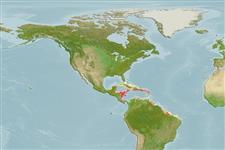Klassifizierung / Names
Namen | Synonyme | Catalog of Fishes(Gattung, Arten) | ITIS | CoL | WoRMS | Cloffa
>
Ovalentaria/misc (Various families in series Ovalentaria) >
Grammatidae (Basslets)
Etymology: Lipogramma: Name formed from 'lipo' for 'without' and 'gramma' for 'a line of text', referring to the absence of a well-developed lateral line; rosea: Named for its body's rosy coloration.
Environment: milieu / climate zone / depth range / distribution range
Ökologie
seewasser demersal; tiefenbereich 5 - 45 m (Ref. 26884). Tropical
Western Central Atlantic: Isla de Providencia and Puerto Rico.
Size / Gewicht / Alter
Maturity: Lm ? range ? - ? cm
Max length : 4.8 cm SL Männchen/unbestimmt; (Ref. 51183)
Rare species (Ref. 51183).
Life cycle and mating behavior
Geschlechtsreife | Fortpflanzung | Ablaichen | Eier | Fecundity | Larven
Dennis, G.D., D. Hensley, P.L. Colin and J.J. Kimmel, 2004. New records of marine fishes from the Puerto Rican plateau. Caribb. J. Sci. 40(1):70-87. (Ref. 51183)
IUCN Rote Liste Status (Ref. 130435: Version 2024-1)
Bedrohung für Menschen
Harmless
Nutzung durch Menschen
Fischereien: kommerziell; Aquarium: Kommerziell
Tools
Zusatzinformationen
Download XML
Internet Quellen
Estimates based on models
Preferred temperature (Ref.
123201): 27.2 - 28.2, mean 27.7 °C (based on 62 cells).
Phylogenetic diversity index (Ref.
82804): PD
50 = 0.5003 [Uniqueness, from 0.5 = low to 2.0 = high].
Bayesian length-weight: a=0.01122 (0.00514 - 0.02450), b=3.04 (2.87 - 3.21), in cm total length, based on all LWR estimates for this body shape (Ref.
93245).
Trophic level (Ref.
69278): 3.3 ±0.4 se; based on size and trophs of closest relatives
Fishing Vulnerability (Ref.
59153): Low vulnerability (10 of 100).
